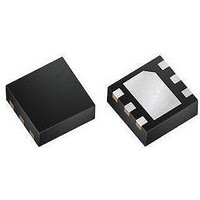MAX9635ESA+ Maxim Integrated Products, MAX9635ESA+ Datasheet - Page 6

MAX9635ESA+
Manufacturer Part Number
MAX9635ESA+
Description
Optical Sensors - Board Mount LOW-POW AMBIENT LIGHT SENSR W/ADC
Manufacturer
Maxim Integrated Products
Datasheet
1.MAX9635EDTT.pdf
(20 pages)
Specifications of MAX9635ESA+
Supply Current
0.65 uA
Operating Supply Voltage
1.7 V to 3.6 V
Package / Case
uTDFN-6
Maximum Operating Temperature
+ 85 C
Minimum Operating Temperature
- 40 C
Lead Free Status / RoHS Status
Lead free / RoHS Compliant
Industry’s Lowest-Power
Ambient Light Sensor with ADC
The MAX9635 is an ambient light sensor with integrated
photodiode and ADC with an I
measure ambient light, the die is placed inside an
optically transparent (OTDFN) package. A photodi-
ode inside the IC converts the light to a current that is
then processed by low-power circuitry into a digital bit
stream. This is digitally processed and stored in an out-
put register that is read by an I
programmable interrupt function eliminates the need for
continually polling the device for data and results in sig-
nificant power saving.
A package-level optical filter prevents ultraviolet
and infrared from reaching the photodiode. Its opti-
cal response is also designed to match the spectral
response of the human eye. A second photodiode array,
sensitive primarily to the infrared spectrum, is then used
to match flourescent and incandescent light response
from the part.
Two key features of the IC analog design are its ultra-low
current consumption (typically 0.65µA) and an extremely
wide dynamic light range that extends from 0.045 lux to
188,000 lux—more than a 4,000,000 to 1 range. The on-
chip autoranging scheme requires no user intervention
for the gain-range setting.
The IC can be customized to operate at enhanced sen-
sitivity in applications where it needs to operate behind
a dark glass.
Figure 1. Spectral Sensitivity of the MAX9635 and Human Eye
6
Detailed Description
2
2
C interface. An on-chip
C digital interface. To
120
100
80
60
40
20
0
300
400
500
WAVELENGTH (nm)
600
MAX9635 RESPONSE
The default integration time of the ADC is 100ms, giving
it inherent rejection of 50Hz and 60Hz ripple common in
certain line-powered light sources.
The IC is designed to detect brightness in the same way
as human eyes do. To achieve this, the sensor needs to
have a spectral sensitivity that is similar to that of human
eyes. Figure 1 shows the spectral sensitivity of the IC
and the human eye (CIE curve).
As can be seen, the human eye has its peak sensitivity
at 555nm (green), while that of blue (~470nm) and red
(~630nm) is much lower. The human eye also is blind to
infrared (> 700nm) and ultraviolet (< 400nm) radiation.
Light sources can have similar visible brightness (lux), but
different IR radiation content (because the human eye is
blind to it). The differences in the light spectra affect bright-
ness measurement because some of this infrared radiation
is picked up by silicon photodiodes. For example, light
sources with high IR content, such as an incandescent
bulb or sunlight, would suggest a much brighter environ-
ment than our eyes would perceive them to be. Other light
sources, such as fluorescent and LED-based systems,
have very little infrared content. The IC exhibits good IR
rejection and internal IR compensation scheme to minimize
these effects and give an accurate lux response.
700
CIE
800
900
1000
Human Eye CIE Curve and
Different Light Sources












